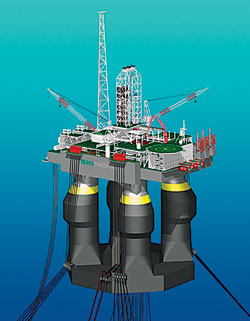 |
Italy |
|
Top tensioned riser for floating dry tree units
A. De Sanctis, M. Ghezzi, P. Monti and A. Radicioni, Saipem Energy International
Development of deepwater oil and gas fields through a Dry Tree Completion Unit (DTU) represents a viable alternative to the subsea wells tied back to a floating production system. The dry trees development, compared with the wet trees, offers a number of distinct advantages. They are related to the direct access for well intervention resulting in enhanced reservoir monitoring, inspection and maintenance operations and associated reduced loss of production and field economic productivity. In addition, the DTU offers a permanent platform allowing for full production facilities, workover and drilling operation.
 |
Octabuoy Dry Tree Completion Unit alternative to tied-back seafloor completion systems.
|
|
Moreover, CAPEX can be increased, but the reduced OPEX at the end of total field life cycle costs can be lower than that related to the corresponding subsea development.
Three field proven deepwater DTU concepts are available: the Tension Leg Platform (TLP), the conventional SPAR, and the truss-SPAR. A novel concept, named Octabuoy has been developed by Moss Maritime, a Saipem Group Co. It is a DTU floating platform that can be configured starting from a simple dry tree wellhead platform up to a full production unit including workover or full drilling capabilities, see figure. It can be also proposed for wet trees developments in harsh environments, like a conventional semi-sub, but with better motion performances.
The Octabuoy-based DTU presents many advantages, compared with TLPs – SPARs, because even in presence of relatively limited hull weight, it can:
- Accommodate a large number of dry or wet wells
- Sustain a large payload allowing for a high production capacity and/or full drilling, and
- Be suitable for deep to ultra-deep water applications.
The particular shape of the columns is the main innovation of the Octabuoy floater with respect to the conventional semi-sub, since it induces elimination of heave-induced roll (a feature of SPAR-type hulls). In addition to extremely favorable heave and pitch and roll motions, a very small offset is also experienced.
The most innovative aspects of Octabuoy are: the Top Tensioned Risers (TTRs) configuration, the relevant Tensioning System, and the Wellbay.
The TTRs are envisaged for production and/or drilling – workover purposes. The system architecture of the TTR system is similar to the one adopted for TLP units, but requirements in terms of motion and stroke are almost similar to the one experienced in SPAR units. Both dual and single casing configuration can be designed, in accordance with the operator’s requirements and/or risk assessment considerations.
A typical dual casing production riser stack-up, starting from the seabed, would contain, as the main riser components: tie-back connector, stress joint, riser joint (with and without helical strakes), lower and upper transition joints, keel joint, tension joint, tensioner assembly, surface wellhead system, tree, and production flexible jumper.
The TTR configuration of the Octabuoy differs from that of the SPAR or TLP, mainly because of the top tensioning system and because of the interaction between the riser and the floating platform.
A conventional hydro-pneumatic tensioning system (HPTS), with remote accumulators and air pressure vessels, has been selected for this application. The HPTS is similar to the one installed on a TLP, but it is able to accommodate higher riser strokes, comparable with the ones on a SPAR or by a drilling tensioned riser. With respect to the drilling riser, the challenge is the reliability of the system, to be guaranteed along the whole field life: to this purpose, an original configuration including the wellbay layout has been studied, together with maintenance requirements.
The wellbay is located in the center of the Octabuoy, normally at the lowest deck level. It is supported by the riser support frame (RSF), a dedicated structure able to transfer the riser loads (the top tension and the tensioning system weight) to the topside and then to the hull. Above the RSF and the wellbay is located the moonpool, that is an open area, crossing the three deck levels, where the upper part of the risers (trees with their relevant work platform, flexible jumpers) are allowed to move without interfering with the topside. At the top of the topside moonpool, the drilling – workover rig is installed.
The Octabuoy concept can effectively face the comparison with more consolidated and field proven DTU concepts for a dry tree field development such as TLPs and SPARs. Octabuoy enters the technological challenge combining features of the TLP (such as the larger number of TTRs due to a large wellbay and the use of a consolidated tensioning system) with the peculiarities of a SPAR (such as the capacity to sustain a large payload) and guaranteeing a high production capacity and/or a full drilling facility.
Moreover, the concept has the possibility to accommodate SCRs, allowing a higher flexibility for field development, including subsea well completion. The Octabuoy hull provides two advantages to the conventional SCR configuration: 1) a lower first order vessel motion, inducing a lower fatigue damage, and 2) a flexibility in the location of the riser hang-off. 
|




